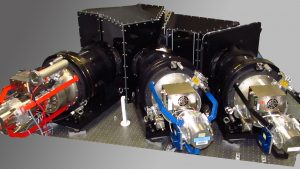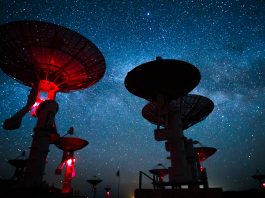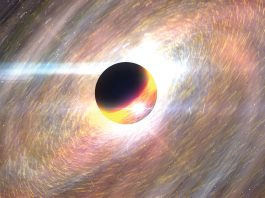Nathalie Palanque-Delabrouille explains how the Dark Energy Spectroscopic Instrument (DESI) will be able to address several of the most challenging questions of cosmology and further improve our understanding of the dark Universe.
Despite millennia of observations devoted to the cosmos and a well-established Standard Model of particle physics that classifies all the known elementary particles and explains with remarkable precision three of the fundamental forces that relates them, the composition of the Universe has been resisting scientists for almost a century. The model that best describes cosmological observations requires that only 5% of the Universe be in the form of ordinary matter, 25% in the form of dark matter of unknown nature, and 70% in a form dubbed ‘dark energy’ that behaves like nothing else and causes the unexpected – and otherwise unexplainable – acceleration of the expansion rate of the Universe. No wonder, then, that understanding the dark Universe has become one of the top-priority challenges that cosmologists face today! Physicists at the French Alternative Energies and Atomic Energy Commission (CEA) are playing a major role in this quest.
Tackling dark matter at the frontier between astrophysics and particle physics
Among the various forms that dark matter could take, one of particular interest is neutrinos. In the standard theory, there are three neutrinos whose masses are known to be non-zero but so small that no experiment has yet been able to measure them.
It has taken billions of years for the hydrogen in the Universe to spread out and then to coalesce onto gravitational potential wells and form the structures we can observe today: filaments, galaxies, and clusters of galaxies, from the sparsest to the clumpiest. If most of the dark matter in the Universe is typically as massive as the known elementary particles, then it is responsible for the primordial potential wells. Dominating the mass budget of the Universe, the gravitational behaviour of dark matter rules, and any seed of dark matter over-density in the early Universe will collapse and form the cosmic web, i.e. the clumpy structure of today’s Universe.
Neutrinos are remarkable exceptions to this scenario. A billion times more abundant than hydrogen atoms but at least a billion times lighter, neutrinos impact the formation of structure in a unique way. During most of the history of the Universe, neutrinos propagate at ultra-relativistic speed and do not cluster in potential wells. They instead tend to smooth them out, at least on the scales they cover while being relativistic (see Fig. 1). At late times, in contrast, neutrinos have slowed down sufficiently to behave just like ordinary matter. Their dual behaviour is affected by their mass, and can therefore be used to study it.
This a not a meager task. The impact is tiny, and can only be seen on scales of a few mega-parsec (Mpc) where many astrophysical phenomena modify the properties of the cosmic web, such as the reionisation of the Universe that occurred early on, or the energy ejection into the intergalactic medium of supernovae and active galactic nuclei. To properly take these effects into account, the only solution is to resort to the use of costly numerical simulations. Thanks to both national (GENCI) and European (PRACE) calls, physicists from the Department of Particle Physics (DPhP) at CEA have obtained over fifty million hours at the Très Grand Centre de Calcul near Paris, France. This is an infrastructure for scientific high-performance computing and Big Data, hosting petascale supercomputers. The project involved simulating areas of the Universe, varying the masses of neutrinos and other parameters describing the cosmos and the intergalactic medium. These simulations were then compared to data from the Sloan Digital Sky Survey (SDSS) that created the most detailed three-dimensional maps of the Universe to date. The latest results allowed the group to set the most stringent bounds ever obtained on the sum of the three neutrino masses, at the level of 0.11 electron volts, an order of magnitude more stringent than can be achieved using particle physics experiments that look directly at neutrinos produced in tritium radioactive decays.
The story does not end there. With its grid of numerical simulations, the CEA group can also address extensions to the Standard Model, focusing in particular on hypothetical particles called sterile neutrinos. Although heavier and less abundant than standard neutrinos, these particles are still sufficiently light to smooth out the smaller structures in a similar manner. Trying to explain what the bulk of the dark matter could consist of, the group could exclude various theories of sterile neutrinos. To go beyond what has been achieved so far requires not only more refined simulations, to better take into account the details of what occurs at the same time on large cosmological distances as well as on galactic scales, but also new data that will provide the physicists with a more accurate map of the cosmic web.

Tackling dark energy with the Dark Energy Spectroscopic Instrument (DESI)
To further improve our understanding of the dark Universe, new-generation experiments are required. Among these, DESI is one of the first to start its science survey. DESI is a spectroscopic instrument located at Kitt Peak observatory, Arizona, USA. It possesses a focal plane equipped with 5,000 robotically-positioned fibres that capture the light of distant galaxies. Planned to run for five years, DESI will measure the spectra of 35 million galaxies, ten times more than its predecessor SDSS, with which it will build the largest and most accurate three-dimensional map of the Universe.
Except for the four-meter mirror which already equipped the telescope, all other parts of the instrument are brand new, and Europe had a significant share in the construction. France designed and built the ten spectrographs and the thirty cryostats that house the CCD detectors. The United Kingdom provided the wide-field corrector consisting of six huge lenses, each about a metre in diameter, as well as the 5,000 optical fibres that run for 33 metres from the focal plane to the spectrographs. Spain contributed the cameras used for the instrument focus and guiding. The commissioning of DESI, finished in April 2020, demonstrated that the instrument performance was excellent and passed all specifications.
With these new maps covering twenty times more volume than any previous experiment, DESI will be able to address several of the most challenging questions of cosmology. It will measure with sub-percent level precision the distances between galaxies at various epochs in the history of the Universe, going back in time to when the Universe was only about 10% of its current age. Because galaxies are separated by a preferred scale, of 150 Mpc today, which only evolves because of the Universe expansion, this measurement will allow DESI to determine with unprecedented accuracy the impact of dark energy on the expansion history of the Universe, hence constraining its nature. DESI will also explore how gravity shaped the growth of the cosmic web and test the compatibility of the observations with predictions from General Relativity, enabling a determination of whether Einstein’s theory still holds or if modifications are required. DESI will also push our knowledge of neutrino properties one step further. For the first time, DESI will have the power to determine the masses of the standard neutrinos, while all previous projects could only set bounds. At CEA, the DPhP cosmology group is getting ready to get the most out of the amazing data soon to come.
Nathalie Palanque-Delabrouille
Co-Spokesperson of DESI
nathalie.palanque-delabrouille@cea.fr
Tweet @CEAIrfu
http://irfu.cea.fr
Please note, this article will also appear in the third edition of our new quarterly publication.









